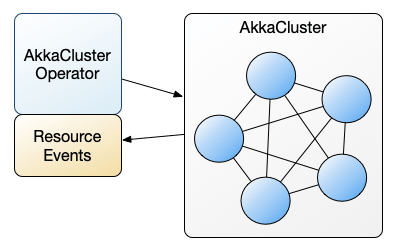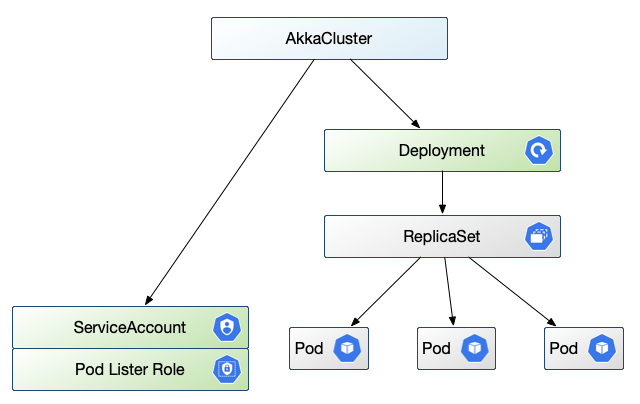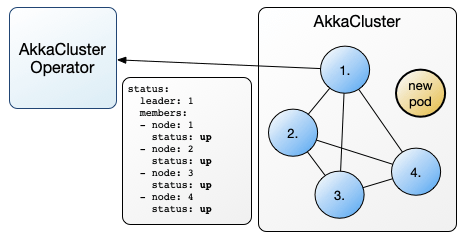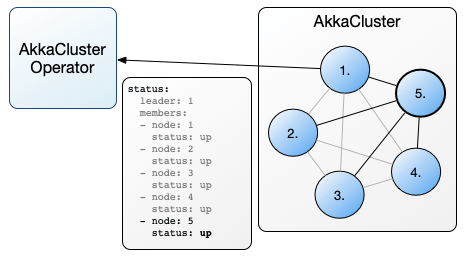The Akka Cluster Operator runs applications built with Akka Cluster on Kubernetes.
Akka Cluster provides a fault-tolerant, decentralized, peer-to-peer based cluster membership service with no single point of failure. Akka Cluster allows for building distributed applications, where one application or service spans multiple nodes.
Akka applications can be run in Kubernetes as plain Deployments using Akka Management, which provides bootstrap via the Kubernetes API and cluster status via HTTP. See, for example, this guide to deploying Lagom on OpenShift. One can carefully configure the application to keep environment settings separate from application settings, to achieve the ability to deploy the same application into different environments without rebuilding the application itself.
This operator builds upon those foundations, providing a top level AkkaCluster resource for interacting with application clusters, giving environmental context to each instance, handling requirements like keeping pod selectors unique and consistently specified, and providing a way to view cluster status in a Kubernetes resource.
The Akka Cluster Operator can be installed from OperatorHub.io.
OperatorHub Operators require the Operator Lifecycle Manager (OLM) controller extensions. With the OLM extensions available, the Akka Cluster Operator can be installed directly from the OperatorHub repository.
See the installation instructions at OperatorHub.io for the exact commands.
The Akka Cluster Operator manages user defined applications built using Akka Cluster and deployed as an AkkaCluster.
Akka Cluster visualizer is an example Java application with those requirements. It forms a cluster, reports status, and has a visualizer endpoint so you can see the application cluster formation over members joining and leaving, and shards rebalancing over the cluster.
The operator and applications under it are loosely coupled. This means the application can run itself and does not require the operator after the initial deployment, so long as top level resources are the same. The operator is only needed to change the number of replicas, or the application image, or other Deployment level kinds of changes. One can think of this operator as Deployment Plus, meaning is just like a Deployment plus a few other things specific to Akka clustering.
Each AkkaCluster resource provides a Deployment spec for an application, which includes a number of replicas for nodes in the Akka Cluster. The Akka Management component calls the Kubernetes API to list application pods, as part of determining cluster membership, so this Operator creates a pod-listing ServiceAccount, Role, and RoleBinding suitable for each application, as well as supervises the Deployment for the application itself.
By default, the operator will create these sub-resources under each AkkaCluster:
-
a ServiceAccount to allow the application to list its own pods. Note that this does not change the default ServiceAccount in the namespace, and every AkkaCluster application has its own ServiceAccount.
-
a Role to be a pod-reader, with RoleBinding to connect the ServiceAccount to the role
-
Deployment per specification, with default ServiceAccount, pod selector, rolling update strategy, and AKKA_CLUSTER_BOOTSTRAP_SERVICE_NAME environment settings.
The operator provides a number of defaults, including a ServiceAccount and Role, as well as for selectors, upgrade strategy settings, labels, and environment variables. These defaults are meant to align with common case needs and defaults in Akka Management, and are meant to be easily reviewed by inspecting the generated Deployment for your application.
For example, an AkkaCluster might generate this Deployment, with all the defaults laid out for easy review:
apiVersion: apps/v1
kind: Deployment
metadata:
name: akka-cluster-demo
spec:
replicas: 4
selector:
matchLabels:
app: akka-cluster-demo
strategy:
rollingUpdate:
maxSurge: 1
maxUnavailable: 0
type: RollingUpdate
template:
metadata:
labels:
app: akka-cluster-demo
spec:
containers:
- env:
- name: AKKA_CLUSTER_BOOTSTRAP_SERVICE_NAME
value: akka-cluster-demo
image: akka-cluster-demo:1.1.0
# ...
serviceAccountName: akka-cluster-demoIf you would like to use your own ServiceAccount, for example, you would set the
serviceAccountName field in the AkkaCluster template spec to your preferred value:
apiVersion: app.lightbend.com/v1alpha1
kind: AkkaCluster
metadata:
name: akka-cluster-demo
spec:
replicas: 4
template:
spec:
serviceAccountName: my-custom-service-account
containers:
# - ...The operator will notice that you have specified a value and will not create the default ServiceAccount, Role or RoleBinding, leaving the creation and maintenance of those resources alone.
Note that in contrast the default ServiceAccount and Role resources are created and marked "owned-by" the AkkaCluster resource, so that Kubernetes cleans them up as a group. If you delete the AkkaCluster, the default sub-resources under it are all cleaned up automatically. But if you specify your own ServiceAccount, the operator will not bind it to the AkkaCluster. It will be referenced as you specify, but otherwise left alone, meaning your custom resources must be created and deleted independent of the application.
Similarly if you want different selector, strategy, labels, or any override of a default,
you can specify your preferred values in the AkkaCluster spec. The operator will only
provide defaults for unspecified fields, and will not override your preferences. The
operator does not look into your application.conf either, so you must make sure you are
applying environmental configuration consistently where you do not use the defaults.
Each AkkaCluster resource has a top level status section that shows members of the
cluster, reachability issues, and role assignments. This content is from the point of view
of the cluster leader, and reflects content from its Akka Management
endpoint
which is located via a named management port in the application pod. The operator polls
the leader for updates after every resource event.
Example, from kubectl get akkaclusters -o yaml:
- apiVersion: app.lightbend.com/v1alpha1
kind: AkkaCluster
# omitting metadata: and spec: sections
status:
cluster:
leader: akka.tcp://akka-cluster-openshift@172.17.0.10:2552
members:
- node: akka.tcp://akka-cluster-openshift@172.17.0.10:2552
roles:
- dc-default
status: Up
- node: akka.tcp://akka-cluster-openshift@172.17.0.11:2552
roles:
- dc-default
status: Up
- node: akka.tcp://akka-cluster-openshift@172.17.0.12:2552
roles:
- dc-default
status: Joining
oldest: akka.tcp://akka-cluster-openshift@172.17.0.10:2552
oldestPerRole:
dc-default: akka.tcp://akka-cluster-openshift@172.17.0.10:2552
unreachable: []
lastUpdate: "2019-06-05T22:11:39Z"
managementHost: "172.17.0.10"
managementPort: 8558The managementHost and port show the source of this cluster status, so in the above
example the data come from
curl http://172.17.0.10:8558/cluster/members/The lastUpdate timestamp shows the last time that status changed. If you want to see
when the operator last polled for status you can find that in its log.
To better understand what happens between the Operator and the Cluster, let's look at the
scenario of scaling an AkkaCluster up by adding a node. Say the existing cluster is
already running at replicas: 4
apiVersion: app.lightbend.com/v1alpha1
kind: AkkaCluster
metadata:
name: akka-cluster-demo
spec:
replicas: 4
template:
spec:
containers:
- name: main
image: registry.lightbend.com/lightbend-akka-cluster-demo:1.1.0
ports:
- name: http
containerPort: 8080
- name: remoting
containerPort: 2552
- name: management
containerPort: 8558From that AkkaCluster resource, the Operator has made a Deployment, a ServiceAccount, Role
and RoleBinding, and has set workable defaults for Akka Management. These defaults include
spec.selectorso the ReplicaSet works correctly and on the same selector basis as Akka Bootstrapspec.strategyto get one-at-a-time rolling updates with no reduction in capacityspec.template.metadata.labels.appset to the unique name of this cluster- container environment variable
AKKA_CLUSTER_BOOTSTRAP_SERVICE_NAMEset to that same value so Akka Bootstrap works on the same basis as the ReplicaSet
Now set replicas: 5. The Operator will propagate that change down to the Deployment. A
new pod with the same template will start. The Operator will start polling the cluster
leader for status changes.
Once the application in the new pod starts, it initiates Akka Bootstrap. By way of the
ServiceAccount that permits reading pods, it gets a list of pods from Kubernetes. These
pods have the unique label app=${AKKA_CLUSTER_BOOTSTRAP_SERVICE_NAME} and are in the
Running phase, not marked for deletion, to avoid old or soon-to-be-deleted pods. In our
case it lists the 4 running pods in the cluster and starts gossip connections with them.
The leader will add the node to the members list and mark it as Joining the cluster.
The Operator will update status to show the new node, and keep polling for status changes.
Presuming all is well and the cluster members can reach the new node, the leader will promote it to Up and it will start taking cluster work.
The Operator will update status to show the new Up node, and from here will likely not get further status changes until some future change to pod resources.
The AkkaCluster Operator is for use with applications using Akka Management v1.x or newer, with both Bootstrap and HTTP modules enabled, and a management port defined to use discovery.
The minimal application.conf settings required are to enable kubernetes discovery:
akka.management {
cluster.bootstrap {
contact-point-discovery {
discovery-method = kubernetes-api
}
}
}
The ActorSystem name should be unique for each desired application cluster.
As noted in Akka Cluster Bootstrap "Akka management must be started as well as the bootstrap process." Be certain to include:
// Akka Management hosts the HTTP routes used by bootstrap
AkkaManagement.get(system).start();
// Starting the bootstrap process needs to be done explicitly
ClusterBootstrap.get(system).start();




